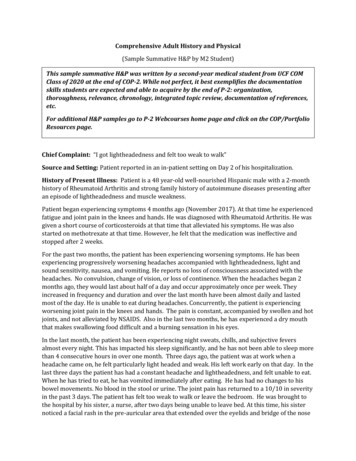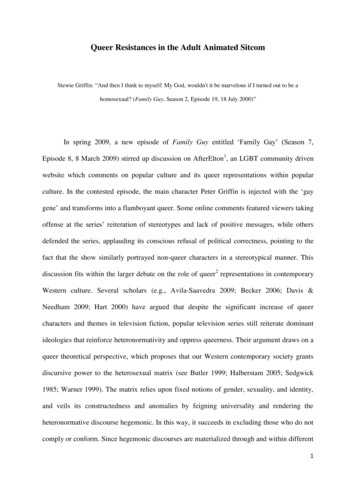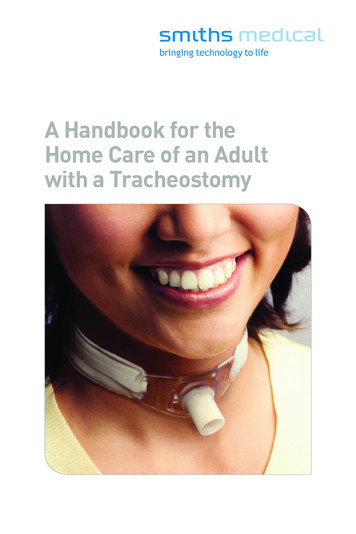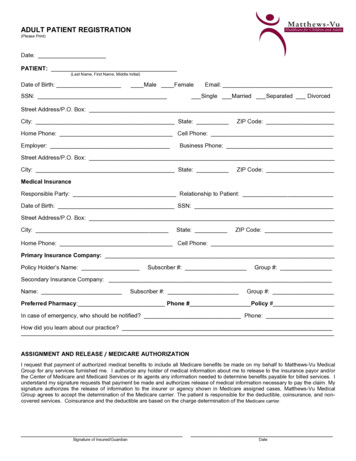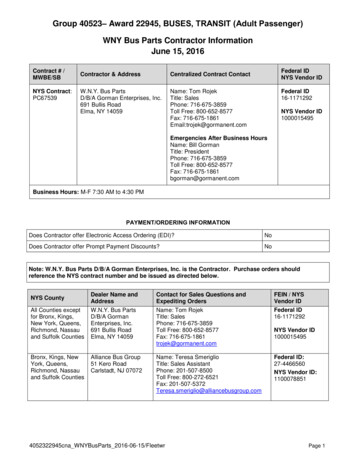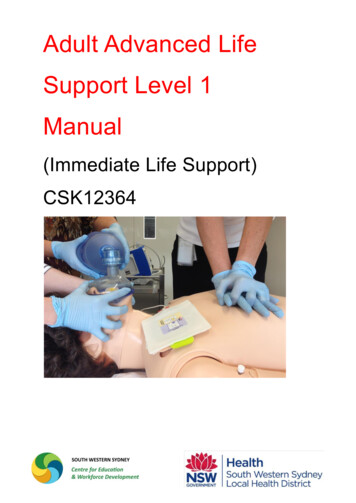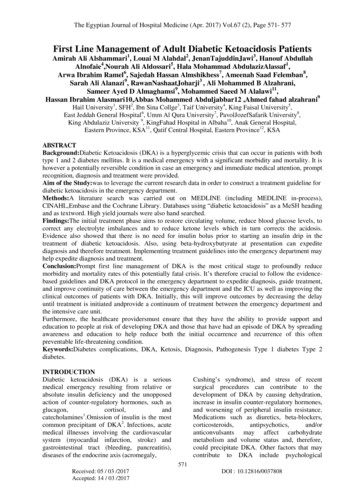
Transcription
The Egyptian Journal of Hospital Medicine (Apr. 2017) Vol.67 (2), Page 571- 577First Line Management of Adult Diabetic Ketoacidosis PatientsAmirah Ali Alshammari1, Louai M Alahdal2, JenanTajuddinJawi3, Hanouf AbdullahAlnofaie4,Nourah Ali Aldossari5, Hala Mohammad AbdulazizAlassaf1,Arwa Ibrahim Ramel6, Sajedah Hassan Almshikhess7, Ameenah Saad Felemban8,Sarah Ali Alanazi9, RawanNashaatJoharji3 , Ali Mohammed B Alzahrani,Sameer Ayed D Almaghamsi9, Mohammed Saeed M Alalawi11,Hassan Ibrahim Alasmari10,Abbas Mohammed Abduljabbar12 ,Ahmed fahad alzahrani9Hail University1, SFH2, Ibn Sina Collge3, Taif University4, King Faisal University5,East Jeddah General Hospital6, Umm Al Qura University7, PavolJozefSafarik University8,King Abdulaziz University 9, KingFahad Hospital in Albaha10, Anak General Hospital,Eastern Province, KSA11, Qatif Central Hospital, Eastern Province12, KSAABSTRACTBackground:Diabetic Ketoacidosis (DKA) is a hyperglycemic crisis that can occur in patients with bothtype 1 and 2 diabetes mellitus. It is a medical emergency with a significant morbidity and mortality. It ishowever a potentially reversible condition in case an emergency and immediate medical attention, promptrecognition, diagnosis and treatment were provided.Aim of the Study:was to leverage the current research data in order to construct a treatment guideline fordiabetic ketoacidosis in the emergency department.Methods:A literature search was carried out on MEDLINE (including MEDLINE in-process),CINAHL,Embase and the Cochrane Library. Databases using “diabetic ketoacidosis” as a MeSH headingand as textword. High yield journals were also hand searched.Findings:The initial treatment phase aims to restore circulating volume, reduce blood glucose levels, tocorrect any electrolyte imbalances and to reduce ketone levels which in turn corrects the acidosis.Evidence also showed that there is no need for insulin bolus prior to starting an insulin drip in thetreatment of diabetic ketoacidosis. Also, using beta-hydroxybutyrate at presentation can expeditediagnosis and therefore treatment. Implementing treatment guidelines into the emergency department mayhelp expedite diagnosis and treatment.Conclusion:Prompt first line management of DKA is the most critical stage to profoundly reducemorbidity and mortality rates of this potentially fatal crisis. It‟s therefore crucial to follow the evidencebased guidelines and DKA protocol in the emergency department to expedite diagnosis, guide treatment,and improve continuity of care between the emergency department and the ICU as well as improving theclinical outcomes of patients with DKA. Initially, this will improve outcomes by decreasing the delayuntil treatment is initiated andprovide a continuum of treatment between the emergency department andthe intensive care unit.Furthermore, the healthcare providersmust ensure that they have the ability to provide support andeducation to people at risk of developing DKA and those that have had an episode of DKA by spreadingawareness and education to help reduce both the initial occurrence and recurrence of this oftenpreventable life-threatening condition.Keywords:Diabetes complications, DKA, Ketosis, Diagnosis, Pathogenesis Type 1 diabetes Type 2diabetes.INTRODUCTIONDiabetic ketoacidosis (DKA) is a seriousmedical emergency resulting from relative orabsolute insulin deficiency and the unopposedaction of counter-regulatory hormones, such asglucagon,cortisol,andcatecholamines1.Omission of insulin is the mostcommon precipitant of DKA2. Infections, acutemedical illnesses involving the cardiovascularsystem (myocardial infarction, stroke) andgastrointestinal tract (bleeding, pancreatitis),diseases of the endocrine axis (acromegaly,Cushing‟s syndrome), and stress of recentsurgical procedures can contribute to thedevelopment of DKA by causing dehydration,increase in insulin counter-regulatory hormones,and worsening of peripheral insulin resistance.Medications such as diuretics, ranticonvulsants may affect carbohydratemetabolism and volume status and, therefore,could precipitate DKA. Other factors that maycontribute to DKA include psychological571Received: 05 / 03 /2017Accepted: 14 / 03 /2017DOI : 10.12816/0037808
First Line Management of Adult Diabetic Ketoacidosis Patientsproblems, eating disorders, insulin pumpmalfunction, and illegal substance use3.It is nowrecognized that new-onset type 2 diabetesmellitus can manifest with DKA4. These patientsare obese, mostly African Americans orHispanics, and extremely insulin resistant onpresentation5.Experimental studies suggest that metabolicacidemia can impair myocardial contractility,reduce cardiac output, affect oxyhemoglobindissociation and tissue oxygen delivery, ase, alter cellular metabolism,and result in vital organ dysfunction 6.Thus, thetarget of therapy in DKA has historically placedimportance on the rapid reversal of acidemia, inaddition to the correction of dehydration andinsulin deficiency7.DKA is a complex medical emergency withseveral stages to the treatment, involvingreassessment at every stage. Upon initialtreatment of DKA in the emergency department,there are varying methods regarding insulinmanagement. Practice differs from some usingold guidelines published by the AmericanDiabetes Association (ADA), some adhere to themost recent Consensus Statement from theADA, while others do not follow any guidelinesat all 8. Currently, there is not a treatmentprotocol regarding the initial treatment of DKAin the Intermountain Urban Central Region.Treatment varies in the amount of insulin givenas well as fluid replacement. Implementation ofa DKA protocol reduces practice variation andhas been associated with a short length of stayand a trend toward decreased cost9.The clinicalsignificance of following a protocol is tostandardize evidence-based treatment of DKApatients, therefore improving clinical outcomesand decreasing cost. Improving emergencydepartment treatment will also be done by stafftraining and expediting treatment.Diabetic ketoacidosis (DKA) can bepreventable, however remains a frequent and lifethreatening complication of type 1 diabetes.Unfortunately, errors in its management arecommon and importantly are associated withsignificant morbidity and mortality. Most acutehospitals have guidelines for the management ofDKA but it is not unusual to find these out ofdate and at variance to those of other hospitals10.Even when specific hospital guidelines areavailable audits have shown that adherence toand indeed the use of these is variable amongstthe admitting teams.The presentreview explores the first lineofassessment,optimal treatments, and theimportance of communication with adult DKApatients.MATERIALS AND METHODSLiterature searchDataSources:electronicdatabasesweresearched: MEDLINE (including MEDLINE inprocess), CINAHL, Embaseand the CochraneLibrary (from 1980).Internetsearch engines such as Google Scholarand EMGoogle, a focused emergency medicinesearch engine were also explored.Search terms diabetic ketoacidosis (DKA),insulin therapy, bolus, adult, treatment guideline,and beta-hydroxybutyrate /complications Data extractionStudy selection and eligibility criteriaFull text articles and studies conducted inEnglish language.Abstracts were also be included to assess varietyof treatment guidelines and outcomes.Study Type: Meta-analysis, practice guidelines,systematic review, and randomized control trialsin line with the study end point.Population: Adults 18 years old as thisprotocol will primarily be used for adults.PathophysiologyDKA is a state which can occur in those withdiabetes, particularly type I diabetes; where thedestruction of beta cells causes a completedeficiency of insulin. It is common in patientswith newly diagnosed type I diabetes or may bethe event which leads to the diagnosis of thecommon long term condition11. DKA can alsooccur at any time if triggered by another factor,most commonly poor insulin control orinfection. Less frequent causes includemyocardial infarction, pulmonary embolism,cerebral accidents or protractedvomiting12, aswell as pancreatitis and drugs 13.DKA occurs when three events take place withinthe body; hyperglycemia, ketosis and acidosis.Hyperglycemia occurs as a result of thedeficiency of insulin apparent in type I diabetesin combination with an increase in hormonesreleased in response to stress, such as glucagon,cortisol, catecholamine, epinephrine and growthhormone14.Deficiency of Insulin preventsglucose being utilized by tissues within the bodyand also increases gluconeogenesis in the liver,both resulting in hyperglycaemia11.572
Amirah Alshammariet al.Insulin deficiency and the increased productionof hormones also cause lipolysis to occur. Thisis the breakdown of fatty acids in the body andresults in the release of Acetyl-coA, which inturn, is converted into ketones; acetone,acetoacetate and most importantly betahydroxybutyrate. This is ketosis and is whatcauses acidosis to occur. Beta-hydroxybutyratecan initially be present in the body without thepresence of acidosis as the acidity is buffered bybicarbonate in the body, resulting in lowbicarbonate in the blood until reserves becomedepleted and acidosis takes over 12.In order to deal with hyperglycemia, the bodyattempts to excrete the excess glucose in theurine along with water, causing polyuria andresulting in dehydration. UK research has foundthat patients in a state of DKA can experienceup to six litres of fluid loss15. This in turn causesan electrolyte imbalance in the body which alsolater needs to be addressed once the immediatethreattolifehasbeenremoved16.KETONES AND ACIDOSISUntil recently, management of DKA hasfocused on lowering the elevated blood glucosewith fluids and insulin, using arterial pH andserum bicarbonate to assess metabolicimprovement. This is based on the assumptionthat this would efficiently suppress ketogenesisand reverse acidosis. This strategy recognizedthat blood glucose is only a surrogate for theunderlying metabolic abnormality. Recentdevelopments now allow us to focus on theunderlying metabolic abnormality (ketonaemia)which simplifies treatment of those who presentwith modest elevation of blood glucose but withacidosis secondary to ketonaemia „euglycaemicdiabetic ketoacidosis‟ 17. This clinicalpresentation is being encountered morefrequently. Improved patient education withincreased blood glucose and ketone monitoringhas led to partial treatment of DKA prior toadmission with consequent lower blood glucoselevels at presentation.DKA DIAGNOSIS and Assessment.Table 1: Diagnostic criteria for diabetic ketoacidosis (DKA)18MeasurePlasma glucose level, mmol/lMild13.9Moderate13.9Severe13.9Arterial or venous pHBicarbonate level, mmol/l7.25–7.3015–187.00–7.2410–14 7.00 10Urine or blood acetoacetate(nitroprusside reaction)PositivePositivePositive 3 3Urine or blood βhydroxybutyrate, mmol/lVariableVariableEffective serum osmolality,mmol/kg* 10 12Anion gap, mmol/lAlertAlert or drowsyAlteration in sensorium* Defined as 2[measured Na (mEq/l)] [glucose (mmol)]. 3Variable 12Stupor or comaDKA TREATMENTFluid Resuscitationfollowing interventions should take place withinthe first hour following admission19.The ADA recommends initial fluid resuscitationwith 0.9% normal saline, a crystalloid fluid,which will be recommended in the ing approaches to the initial fluidresuscitation goal2,recommend initial fluidFluid resuscitation is one of the key elements inthe treatment of DKA as intravascular,intracellular, and interstitial volumes are allreduced in hyperglycemic crisis.The aim totreatment of DKA is to restore circulatingvolume, reduce blood glucose levels, correct anyelectrolyte imbalances and to reduce ketonelevels therefore correcting acidosis. The573
First Line Management of Adult Diabetic Ketoacidosis Patientsreplacement at 15-20 mL / kg body weightwithin the first hour, or 1-1.5 liters within thefirst hour followed by 0.45% NaCl at 250-500mL/hr, with 0.9% NaCl used in cases withhyponatremia. Another regimen of 500 ml/hr of0.9% saline for the first four hours in DKA hasbeen recommended 20. Another study reportedthat an initial infusion of 1-1.5 liters of 0.9%saline is appropriate in most cases. In aprospective, randomized trial involving patientswith no associated illness21, while Caputo et al.22found no significant difference between fluidadministration rates of 500 mL/hr and 1000mL/hr on outcomes regarding morbidity,mortality, ketoacidosis correction, or anion gapclosure.sodium is normal or elevated; 0.9% normalsaline at a similar rate if corrected serum sodiumis low (2009). Similarly, once glucose has fallenbelow hyperglycemic levels, intravenousinfusion is switched to a solution containingglucose to facilitate the closure of the anion gap,such as D5W to avoid hypoglycemia2. Since themaintenance fluid phase of DKA typicallyoccurs in the ICU setting, the current ICUprotocol will be implemented in the treatmentguidelines.InsulinTreatment of hyperglycemia in DKA through aninsulin drip is a well-established treatmentpractice. In a Cochrane review, Fisher,Shahshahani, &Kitabchi26 established thatinsulin falls fastest in the first two hours in DKAwith insulin given intravenously, and that this isthe preferred route. The data also confirmed theefficacy of low-dose insulin therapy for DKA26.Wagner et al. 27 established the use of very lowdose insulin treatment for DKA. The results oftheir study indicated that very low dose insulinwas useful to prevent the rapid fall in bloodglucose or rapid electrolyte displacement27.Regular and glusiline insulin have been found tobe equally effective during the treatment ofDKA 28.According to these results, emergencyguidelines will recommend initial fluidresuscitation of 1.5 liters 0.9% normal salinebolus within the first hour, followingrecommendations
DKA DIAGNOSIS and Assessment. Table 1: Diagnostic criteria for diabetic ketoacidosis (DKA)18 Measure Mild Moderate Severe Plasma glucose level, mmol/l 13.9 13.9 13.9 Arterial or venous pH 7.25–7.30 7.00–7.24 7.00 Bicarbonate level, mmol/l 15–18 10–14 10 Urine or blood acetoacetate (nitroprusside reaction) Positive Positive Positive Urine or blood β-hydroxybutyrate, mmol/l 3 3 3 .



